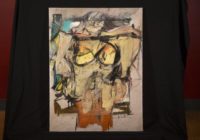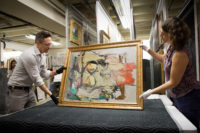 In a happy counterpoint to yesterday’s sad news, a painting by Willem de Kooning stolen from the University of Arizona Museum of Art in Tucson 32 years ago has been found and returned to the museum. Woman-Ochre was snatched November 29th, 1985, the day after Thanksgiving, in a classic two-person misdirection ploy. A woman and a man waltzed into the museum bright and early at 9:00AM. The woman ran interference with the security guard, capturing his attention while her partner cut the painting out of the frame. They quickly left together and that was the last anyone saw of them. The whole operation from entry to exit had taken less than 15 minutes.
In a happy counterpoint to yesterday’s sad news, a painting by Willem de Kooning stolen from the University of Arizona Museum of Art in Tucson 32 years ago has been found and returned to the museum. Woman-Ochre was snatched November 29th, 1985, the day after Thanksgiving, in a classic two-person misdirection ploy. A woman and a man waltzed into the museum bright and early at 9:00AM. The woman ran interference with the security guard, capturing his attention while her partner cut the painting out of the frame. They quickly left together and that was the last anyone saw of them. The whole operation from entry to exit had taken less than 15 minutes.
The subsequent police investigation failed to find the culprits or the painting and for three decades the case was cold as ice. It turned burning hot earlier this month when David Van Auker, Buck Burns and Rick Johnson, owners of Manzanita Ridge Furniture & Antiques in Silver City, New Mexico, bought the painting at an estate sale. Van Auker saw it hanging behind the bedroom door at the home of Jerry and Rita Alter in Cliff, New Mexico, and decided to buy it along with a pile of other assorted gewgaws from the sale. He had no idea it was an original de Kooning; he just thought it was cool.
He propped the painting up against the wall of his shop and a customer told him it looked like a de Kooning. Then another customer noticed it and mentioned it could be a de Kooning oil painting. A third soon joined the chorus. Van Auker started getting antsy. Much Googling ensued, and when he read about the theft from the museum, he realized he very likely had a gazillion dollar stolen painting in his shop. He nervously moved it into the bathroom to keep it out of view of any more customers.
Van Auker called the UAMA and told them he thought he had their long-lost de Kooning. The next day the head of the museum, a curator and a restorer from the Arizona State Museum scrutinized the painting. The restorer examined it for two hours at the end of which she confirmed that it was authentic. After spending a night under lock and key at the local police station, Woman-Ochre was transported back to the museum in Tucson.
“This is a monumental moment for the museum,” said Meg Hagyard, director of UAMA. “We are thrilled at the possibility that this work could once again be on exhibit in our galleries. This is an especially poignant moment, as ‘Woman-Ochre’ was donated by Edward Joseph Gallagher Jr. as part of one of the largest gifts in the museum’s history. Having both the collection and that gift complete once again is something that we’ve always hoped for.
 Woman-Ochre is one of a series of paintings de Kooning did exploring the female form, a subject that many critics and artists asserted had been superseded by abstract, non-representational art. While eschewing the traditional depictions of what he called “the idol, the Venus, the nude,” Kooning drew from a wide range of iconographic references — prehistoric mother goddess figurines, advertising models, pinup girls — to create abstract expressionist versions of figures out of thick lines and dynamic slashes of color.
Woman-Ochre is one of a series of paintings de Kooning did exploring the female form, a subject that many critics and artists asserted had been superseded by abstract, non-representational art. While eschewing the traditional depictions of what he called “the idol, the Venus, the nude,” Kooning drew from a wide range of iconographic references — prehistoric mother goddess figurines, advertising models, pinup girls — to create abstract expressionist versions of figures out of thick lines and dynamic slashes of color.
Paintings in de Kooning’s Woman series today grace the walls of the world’s top museums, and on the rare occasions when they become available on the market, they sell for astronomical prices. Ten years ago one sold for $137.5 million. Bound by the terms of the Gallagher donation, the UAMA cannot sell the painting even if it wanted to, which it most emphatically does not, but based on the comparables, it could be worth something in the neighborhood of $160 million.
At the time of the theft, the painting was insured for $400,000, a risibly small sum compared to its market value today. The museum very wisely put the money in an endowment fund and used the interest to upgrade its security systems. Upon the painting’s return, the museum paid back the original $400,000 to the insurers so they again have clean title to the artwork.
The de Kooning is in need of some tender loving care. The edges are ripped from being hacked out of the original frame and whatever jackass reframed it stapled it to a board. The thieves also rolled it up for ease of transport, making the paint brittle in parts. Thankfully it has not begun to flake yet. Before the painting goes back on display, it will undergo thorough restoration and study. Meanwhile, the FBI is investigating how the stolen work wound up in the nice but humble three-bedroom home of a retired music teacher and a retired speech pathologist.
Well, if the man was 25-30 at the time of the theft, he could be retired now…
Step back, …
I am going to try now .. abstract, non-representational art:
..##
#. :love: #
(o )( o)
-)–+–(
(+-V-+)
I believe the retired music teacher and the retired speech pathologist have some explaining to do, lest they want to spend their retirement years in a spartan abode.
The signature is clear enough, how did it stay missing for so long?
I agree with Albertus. However, an estate sale in the US means just that, a sale to settle the estate of the deceased. The couple may be beyond the reach of anyone these days.
It’s not unusual for people who pull off thefts like this to be art lovers who don’t have money to be art collectors. The stuff doesn’t turn up until someone dies or needs ready cash in a financial crisis and doesn’t have the connections to tap into the underground art market and the work gets noticed by a pawnshop/ antique store owner they try to unload it on with a sharp eye.
In the past thirty years as WWII vets die off, all sorts of art works GI’s brought home with them have been found stashed away by survivors and returned to the countries of origin.
Wow awesome :boogie: . I have this thing for abstract painting finding this painting is really cool. It should be displayed on a museum so it could appreciated by people.
No, please save museums and viewer’s eyes from such a scary copy of Venus of Willendorf. It is in my opinion quite a scary and sad representation. Seriously, does anybody see beauty of a woman’s body in that de Kooning’s work, or the price for a painting is what makes it so attractive? I understand that the more controversial the painting, the more it attracts attention and bids on auctions, but in this case I think about this painting as some kind of a bad joke about women. They are really not that ugly at all.
Hi Roma, scary and sad are part of life, and the fact that you react to it means the art has served its purpose, especially since you felt the need to write about it. As an architect recently stated here in Poland, if no one dislikes her latest building, she knows she has done poor work, just repeated other people’s ideas. 😉
I hang some of my work at work, and I know the good ones because they are the ones that visitors stop to look at. My wife also has one of my pictures on her office wall, and it stops visitors in their tracks while they mentally reprogram their understanding of who my wife is. No reactions, no art.
Hopefully the museum is grateful to the antique dealers who just increased the value of their collection by around $160,000,000. I believe a nice thank you card is in order. 😉
A QUESTION OF VALUES
A cock is strutting in the yard behind the sty,
And scratching out his meal deep down among the burl.
An object ’mid the bits of straw attracts his eye,
He digs it out and sees that it’s a lustrous pearl!
“A treasure you may be to men your jewels adorn,
To me however you are an absurdity.
I’d rather have a single grain of barleycorn,
Than sacks of your variety of luxury!”
Precious things are fine for those who hold them dear,
But nothing, mean to those who have no use, it’s clear.
Alter, H. Jerome. Aesop’s Fables Set in Verse (pp. 153-154). H. Jerome Alter. Kindle Edition.
The stolen de Kooning painting was haphazardly stapled on a board, layered with dust on the wall behind Mr. and Mrs. Alter’s bedroom door.